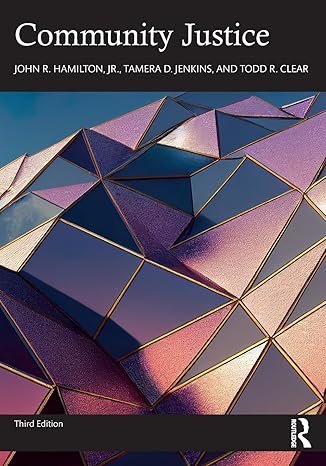Community Justice 2024
Community Justice discusses concepts of community within the context of justice policy and programs and addresses the important relationship between the criminal justice system and the community in the USA.
Taking a bold stance in the criminal justice debate, this book argues that crime management is more effective through the use of informal (as opposed to formal) social control. It demonstrates how an increasing number of criminal justice elements are beginning to understand that developing partnerships within the community that enhance informal social control will lead to stabilization and possibly a decline in crime, especially violent crime, and make communities more livable. Borrowing from an eclectic toolbox of ideas and strategies – community organizing, environmental crime prevention, private–public partnerships, and justice initiatives – Community Justice puts forward a new approach to establishing safe communities and highlights the failure of the current American justice system in its lack of vision and misuse of resources.
This book is essential for undergraduate and postgraduate students of criminology, law, and sociology. It provides detailed information about how community justice fits within each area of the criminal justice system and includes relevant case studies to exemplify this philosophy in action.
Community Justice discusses concepts of community within the context of justice policy and programs and addresses the important relationship between the criminal justice system and the community in the USA.
Taking a bold stance in the criminal justice debate, this book argues that crime management is more effective through the use of informal (as opposed to formal) social control. It demonstrates how an increasing number of criminal justice elements are beginning to understand that developing partnerships within the community that enhance informal social control will lead to stabilization and possibly a decline in crime, especially violent crime, and make communities more livable. Borrowing from an eclectic toolbox of ideas and strategies – community organizing, environmental crime prevention, private–public partnerships, and justice initiatives – Community Justice puts forward a new approach to establishing safe communities and highlights the failure of the current American justice system in its lack of vision and misuse of resources.
This book is essential for undergraduate and postgraduate students of criminology, law, and sociology. It provides detailed information about how community justice fits within each area of the criminal justice system and includes relevant case studies to exemplify this philosophy in action.
Community Justice discusses concepts of community within the context of justice policy and programs and addresses the important relationship between the criminal justice system and the community in the USA.
Taking a bold stance in the criminal justice debate, this book argues that crime management is more effective through the use of informal (as opposed to formal) social control. It demonstrates how an increasing number of criminal justice elements are beginning to understand that developing partnerships within the community that enhance informal social control will lead to stabilization and possibly a decline in crime, especially violent crime, and make communities more livable. Borrowing from an eclectic toolbox of ideas and strategies – community organizing, environmental crime prevention, private–public partnerships, and justice initiatives – Community Justice puts forward a new approach to establishing safe communities and highlights the failure of the current American justice system in its lack of vision and misuse of resources.
This book is essential for undergraduate and postgraduate students of criminology, law, and sociology. It provides detailed information about how community justice fits within each area of the criminal justice system and includes relevant case studies to exemplify this philosophy in action.
Publisher : Routledge; 3rd edition (October 29, 2024)
Language : English
Author: John R. Hamilton Jr. (Author), Tamera D. Jenkins (Author), Todd R. Clear (Author)
Paperback : 204 pages
ISBN-10 : 1032488573
ISBN-13 : 978-1032488578





